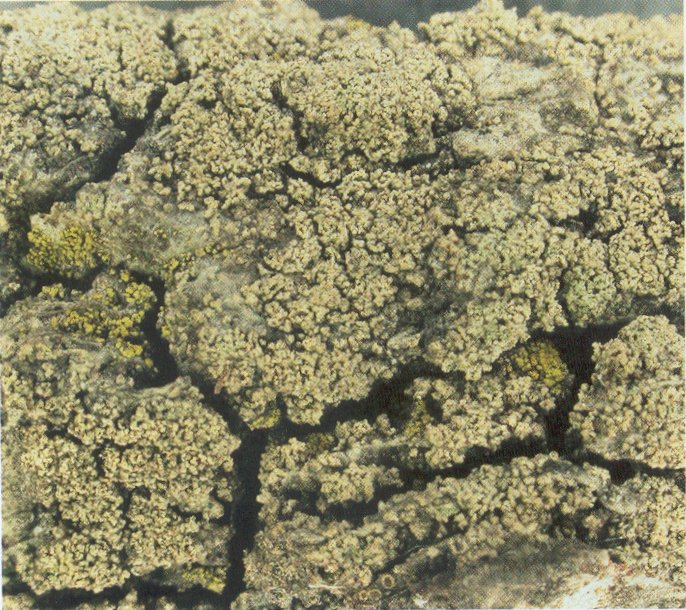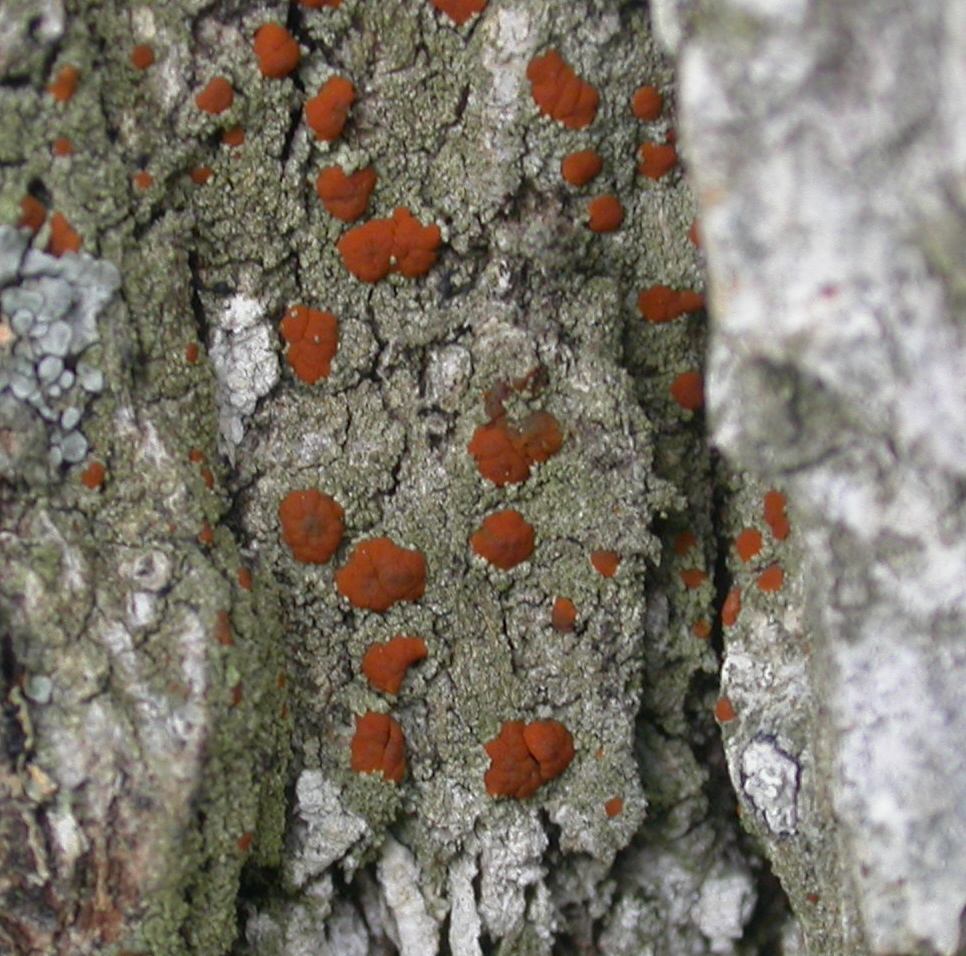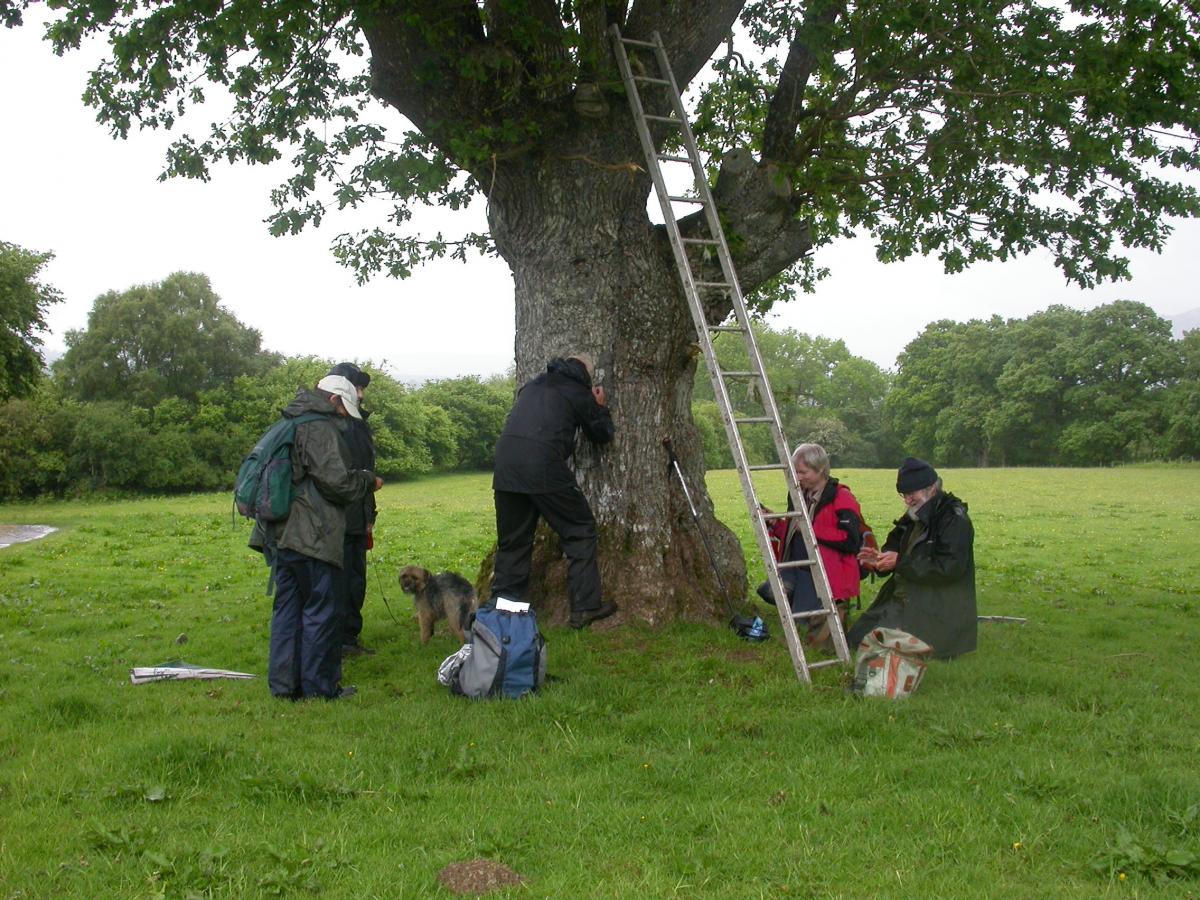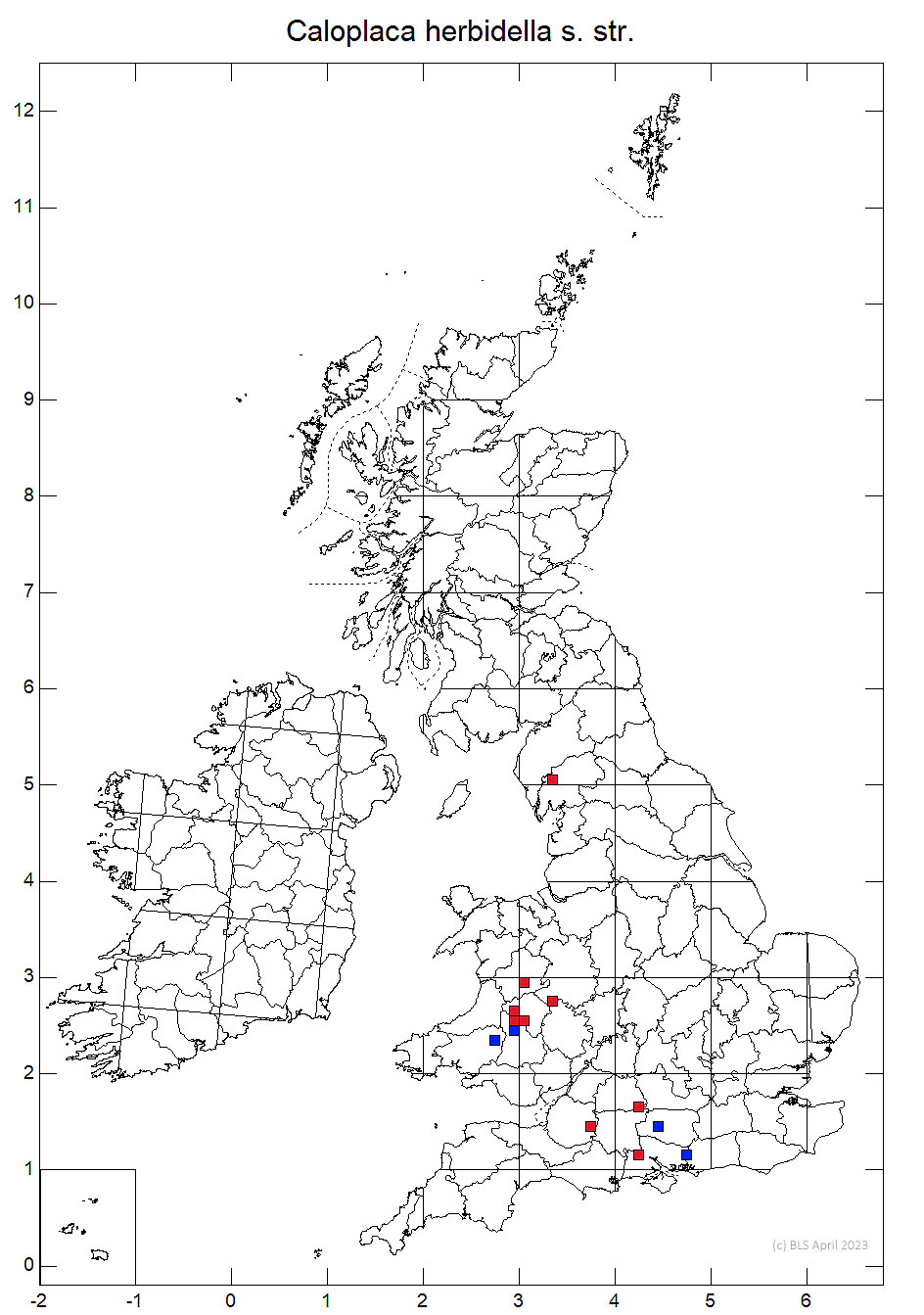Distinguished by abundant white-grey rod-like coralloid isidia (rarely sparse and granular) which cover and obscure much of the thin, elephant grey-coloured thallus. Apothecia are often not present, but when they are they can be abundant and of a wonderful bright rust to perargonium-red colour. They are 1-3 mm diam., rounded to flexuose and the margin is often barely visible and of a similar colour to the disc. Chemical tests: Thallus and isidia K- (isidia tips sometimes K+ faint purple and thalli with a yellow tige may react); apothecia K+ purple.

Thallus with isidia but no apothecia. (Photo: K. van Herk)

Thallus with abundant apothecia. (Photo: Ray Woods)
Recently C. coralliza has been found to be British (Arup & Akelius 2009) with a single record from Levens Park, Cumbria. It occurs also on trees, is very rarely fertile and then with only a few apothecia. Most specimens have a distinct light beige to dark or orange-brown coloured thallus and isidia. The isidia tend to be formed more in discrete coral-like clusters though they may coalesce. When this happens the crust of isidia frequently cracks into seperate islands or areoles. In C. herbidella such dense turves of isidia are rare and never crack. C. herbidella may also superficially resemble Caloplaca ferruginea, though the latter lacks isidia . Thalli without apothecia can resemble forms of some Porina species though they all tend to occur in shaded or sheltered situations and C. herbidella is a lichen of well-lit pasture woodland trees. Caloplaca chlorina has a darker grey thallus with a blue tinge, and occurs on rock rather than trees. Pertusaria coronata is K+ yellow, Pd+ orange.
On old trees in wood pasture. In

Europe, Macronesia, Asia, Africa. S.& S.E. England, mid Wales. (Note the "Flora" mentions a Westmoreland UK population but this has since been re-determined as C. coralliza - see Arup & Akelius, op cit.).
In Britain outside of mid-Wales this species is exceedingly scarce. Only in the New Forest does there appear to be a population approaching that of mid-Wales. Savernake once supported a number of trees with it on but no material has been seen recently and this site is now probably too densely wooded. Indeed there does not appear to be a record of this species from England for over 20 years.
| Location | Grid Reference | Last Rec'd | Recorder | SSSI |
|
Brecknock: S. of Comin-Coch |
SN990541 |
2011 |
R.G. Woods |
No |
| Brecknock: Nr. Pencaer-helm | SN98695415 | 2011 | R.G. Woods | No |
| Brecknock: Garth House | SN941499 | 1997 | R.G. Woods | No |
| Brecknock: Llanwrthwl - Field near Caegarw. | SN978624 | 2011 | R.G. Woods | No |
| Brecknock: Llanwrthwl - near Crynfryn | SN978626 | 2009 | R.G. Woods | No |
| Carmarthen: Glan Bran Deer Park | SN799378 | 1995 | R.G. Woods | No |
| Montgomery: Gregynog Great Wood | SO079976 | 1990 | R.G. Woods | Yes |
| Radnor: Stanage Park | SO3371 | 2007 | Welsh Lichen Group | No |
| Radnor: nr. Newbridge-on-Wye | SO020559 | 2009 | S.P.Chambers | No |
| Radnor, Tyn Coed, Disserth | SO02895541 | 2010 | RG Woods | No |
From Ray Woods:
South of Comin Coch - this population occurs on an ancient trackside oak. It has never been found fertile. By 2009 it was in decline though some recovery was observed in 2011.
Nr, Pencaer-helm - this small population, not fertile occurs on a much younger and probably more acidic tree than others in mid Wales. It occurs at the edge of a pasture where the ground drops steeply away into woodland above the Afon Cwefru.
Cae Garw - here the lichen occurs on a single ancient oak growing in the middle of a sheep-grazed pasture. It is abundantly fertile.
Garth House - originally found on a mature sycamore in 1983. A search in 2011 failed to refind it, though a number of suitable trees remain in the area.
Nr. Newbridge-on-Wye - Steve Chambers recorded a probable colony on oak beside the access track to the BSW sawmill near Newbridge on Wye, This has been wiped out by a Welsh Government road improvement scheme. A small colony was found low down on the SW side of a field boundary ancient oak near Tyn Coed, Disserth. It was not fertile.
Stanage Park - found not fertile in 2007 on the trunk of a golden form of sycamore that also supports Anaptychia ciliaris in the grazed ornamental parkland to the east of the house. Could not be found in 2012 by RGW though there appeared to be few other changes to the tree except greater evidence of slug browsing.
Gregynog Great Wood - the population here occurred on an ancient ash tree at the western extremity of the Great Wood. When first discovered in c.1976 it was fertile. However, over subsequent years it soon ceased to be fertile and the thallus also began to retreat. By 2005 it could no longer be found on this tree. The Lobaria pulmonaria with which it was associated had also declined in lobe size and extent. There had been no obvious local land use changes.
At Stanage and Garth House the species was found on sycamore; at Pencaerhelm, Comin Coch, Glan Bran, near Newbridge on Wye and Llanwrthwl, on oak.
Elsewhere in Britain this species is exceedingly scarce. Only in the New Forest does there appear to be a population approaching that of mid Wales though even here it has never been recorded from more than a handful of trees (Neil Sanderson pers comm.). Savernake once supported a number of trees with it on but no material has been seen recently and this site is now probably too densely wooded (Neil Sanderson pers comm.). Neil has also failed to relocate it at Hurstbourne Park in N. Hants. A recent taxonomic study (Arup,U. & Akelius, E. (2009) in the Lichenologist, 41 pgs 465-480) has shown that some European records of C. herbidella refer to a newly described species, C. coralliza. Most British collections appear to belong to C. herbidella in the strict sense, although a collection from Levens Park in Cumbria has been identified as C. coralliza. A critical re-appraisal of British herbarium material is required. Direct threats come from the loss of the host tree, shading by the growth of adjacent vegetation and ivy and gross eutrophication particularly by the injudicious spreading of farmyard manure and slurry that can coat trees. There are some sites where its loss cannot be accounted for by any obvious change in adjacent land use.(RGW)
UKBAP Signposting Actions:
- Monitor the habitat and species at sites, at least every 6 years, to ensure that owners and occupiers continue to be aware of the presence of this lichen and of its requirements.
- Promote further survey of potentially suitable trees and bring any newly discovered populations into the monitoring/management programme.
- Promote sympathetic land management of areas adjacent to existing populations (particularly through targeted agri-environment schemes) and ensure that existing colonies are not threatened by the growth of overshading vegetation.Make use of any additional records to better refine our understanding of the management requirements of this species. If necessary through tree surgery seek to prolong the life of the host tree for as long as possible.
- Check all herbaria to confirm identity of specimens following discovery of C. coralliza in Britain.
Arup, U. & Akelius, E. (2009). A taxonomic revision of Caloplaca herbidella and C. furfuracea. The Lichenologist 41(5): 465-480
Coppins, B.J & Fletcher,A. (2001). Caloplaca herbidella. Species account 260/2001 in the Caloplaca fascicle of the Lichen Atlas of the British Isles produced by the British Lichen Society, London
- Log in to post comments

